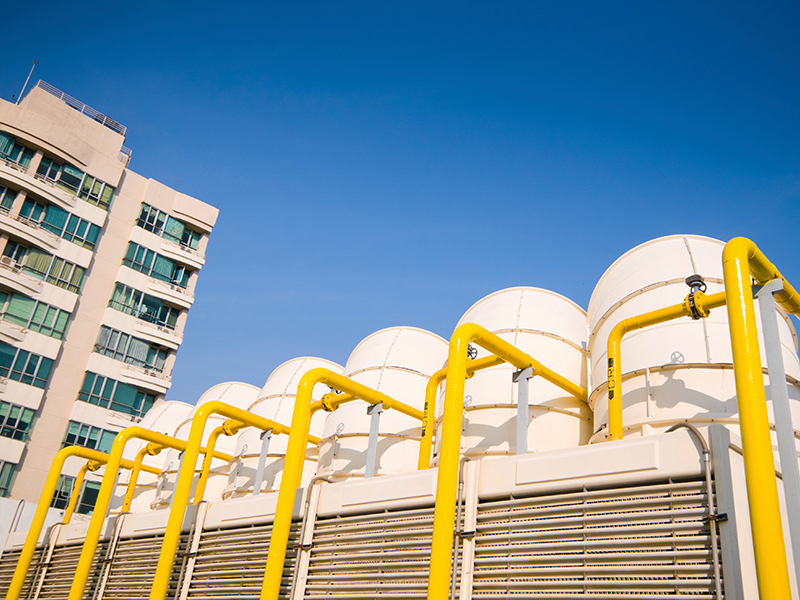Make your startup easier with a proper layup. Protecting your system during the winter season with the right layup program will significantly reduce the amount of chip scale that will loosen up in the spring, prevent corrosion and iron-throw, and greatly extend the life of your equipment.
Kurita America offers four products that can be used for cooling layup: Protect 649, CTL-440, Cetamine E655, and Tower Toads. Each chemical has a best fit, and each chemical must be applied a little differently. (See below to learn more about our layup products).
As with any passivation, the metal (or wooden) surfaces need to be clean. If they are not, they should be cleaned with a cleaner before the actual layup product is applied. The layup product will have some cleaning and slime penetrating ability but are not effective if the surfaces are too dirty, scaled, or fouled. That determination will be made by your Kurita America representative during normal operation prior to shutdown.
Kurita's variety of tower cleaning products can be applied based on your plant’s unique needs:
- Ferroclean or Proclean 335 are used for iron
- Proclean 421 for oily deposits
- Proclean 387 for heavy duty mineral scale
- Proclean 403, 404, 410 for organic slime
During normal operation, a biocide efficacy study should be done to determine the effectiveness of the chosen biocides. An efficient non-oxidizing biocide should be used prior to layup.
Tower Shutdown and Layup Procedure
Preparation
Determine the operational biological condition of your system by doing a bioefficacy test (dip slide) and adenosine triphosphate (ATP) biomass test. Take a sample for Legionella testing if none has been done during the year. Gradually lower the conductivity in the circulating water to the low end of the operation range (or lower). Discontinue the use of your normal scale and corrosion inhibitor(s) and biocide(s). Acid addition may be continued to maintain a desired pH.
Determine System Shut Down Condition
Using visual or analytical deposit analysis, determine the condition of your system and program success. If conditions warrant, clean the system prior to laying up for removal of organic or inorganic deposits or biological slime. Wearing the appropriate personal protective equipment, manually remove any dirt and debris from the tower basin and other accessible areas.
Clean/Passivate the system with a layup product while circulating for at least 24 hours.
Apply the best biocide as determined by your bioefficacy test. If no test was done, then use 300 to 500 ppm of Biotrol 550 and circulate for three hours followed by 100 to 200 parts per million(ppm) of Biotrol 103CF while circulating for at least another hour. Verify kill by testing for both aerobes and anaerobes.
Kurita America's Layup Products
1) PROTECT 649
This volatile corrosion inhibitor based on vapor phase inhibitor (VPI) technologies has azole as one of its ingredients as well as polymer. The normal feed rate is 4000 to 5000 ppm. At that rate, the polymer will be 175 to 225 formazin attenuation units (FAU) on the Hach DR-890 or DR-900. This product is volatile so that it protects parts of the system not contacted by the water. Best results will be achieved in systems which are sealed to prevent air circulation.
2) CTL 440
This product has an advantage where slime is an issue on system surfaces, but it is not considered severe enough to require a special cleaning with Proclean 403. CTL 440 has the capability to passivate mild steel and yellow metal alloys. The normal feed rate is 3200 ppm.
3) Cetamine E655
This product is a liquid corrosion inhibitor based on surface active Cetamine filming amine (CFA). Cetamine E655 is an organic-based chemistry, which prevents corrosion in open recirculating cooling water systems made of steel, cast iron, copper, and copper alloys. It is especially effective in minimizing corrosion in waters with high concentrations of chlorides. It can also be effective preventing white rust on galvanized steel surfaces and for stopping expansion of corrosion in systems where the galvanized coating has previously been compromised. To obtain a protective layup film, Cetamine E655 should be applied for at least 30 days prior to shutdown and layup.
4) Tower Toads
This product is a powdered VPI chemistry in a dissolvable polyvinyl bag. Four “toads” or bags are added per 1000 gallons of cooling system volume. The bags will dissolve in the water, and the VPI chemistry will circulate over the wetted metal. It will also volatilize and form a film on non-wetted surfaces. Tower Toads can also be added to a clean dry system without circulation. The polyvinyl bags need to be slit open to allow the powder to vaporize. The bags should be added to various critical points throughout the cooling system. The same dosage applies (four bags per 1000 gallons system volume). The best long-term protection can be achieved through a combination of circulating a liquid cleaner/passivator and then adding Tower Toads for additional protection after the system is drained. In a tightly closed system, the protective VPI barrier will last up to six months. In an open system, the barrier will fade after a few months.
Conclusion
By protecting your system during the layup season, you can extend equipment life and save time when returning your system to operation again. The short-term adjustments to your layup procedure can help you in the long term.
Contact Kurita America to get started on an updated layup procedure.

